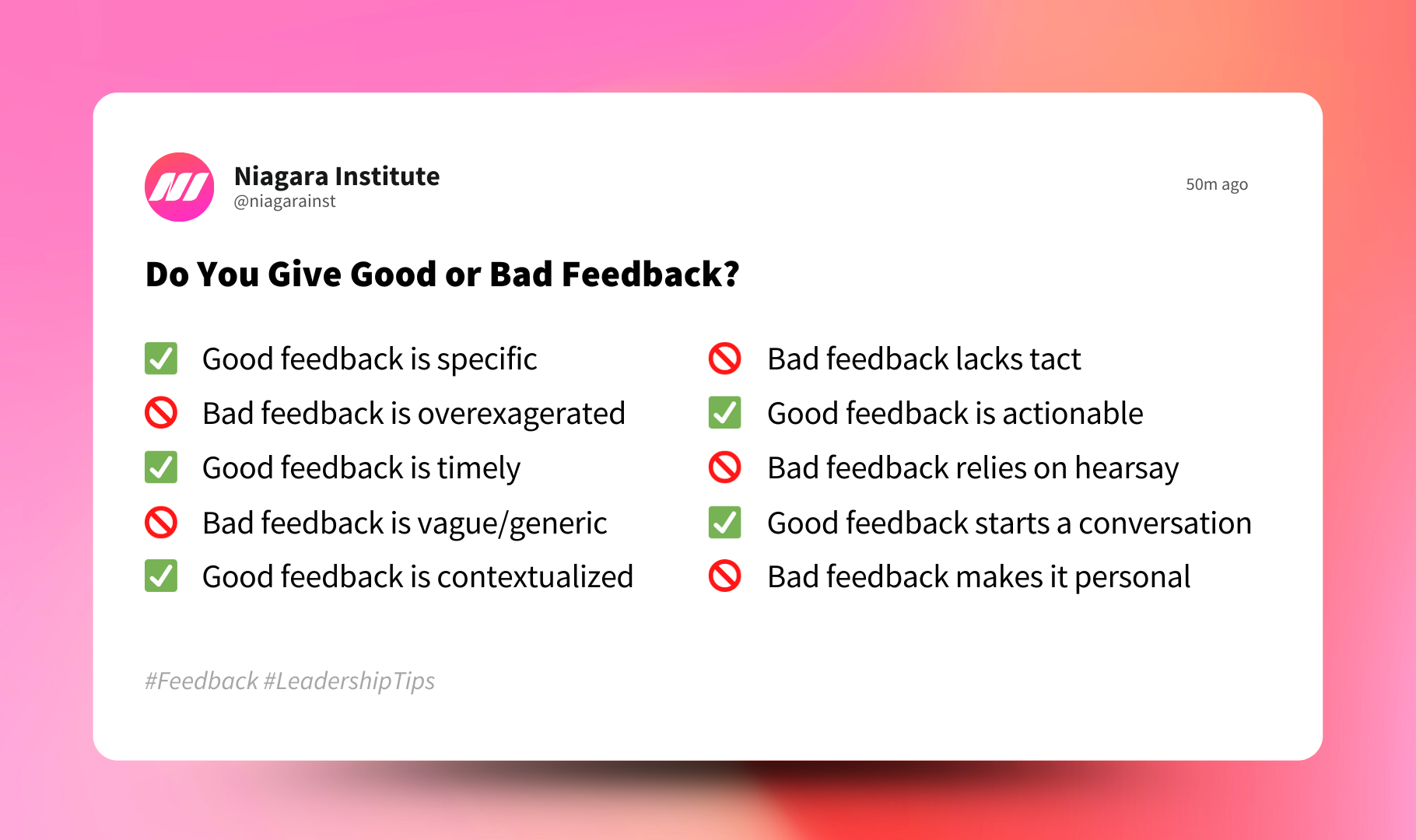8 min read
Positive vs Negative Feedback at Work: Difference + Examples
When you’re at work, do you want to know where you stand with your boss, peers, or clients? Do you want to see whether you’re doing a good job, and...
5 min read
 Michelle Bennett
:
Nov 3, 2023 5:00:00 AM
Michelle Bennett
:
Nov 3, 2023 5:00:00 AM
.png)
If you can get yourself to the point where you’re willing and ready to give someone feedback, whether it be your employee, colleague, or boss, the last thing you want is for it to go bad. That’s because bad feedback confuses, upsets, frustrates, demotivates, and generally annoys people. Not to mention, it reflects poorly on you and can negatively affect your working relationship for a period of time.
To help you get a better sense of the difference between good and bad feedback in the workplace, we’ll review the signs of each, as well as provide you with examples of good and bad feedback so you know exactly what to start, stop, and continue doing when you give feedback in the future.

Good feedback is specific, timely, contextualized, and actionable. Simply put, good feedback is constructive. This means that it comes from a place where you genuinely want to see someone grow and succeed and will help them do so by evaluating their behaviors, actions, or performance and providing them with actionable insights and helpful suggestions.
Bear in mind that good feedback can be positive or negative. What makes good feedback good is the delivery. It should be delivered at the right time, in the right place, and in a respectful way. So, even if the feedback is regarding something negative like a mistake that was made or a problem that was mishandled, it won’t feel unjust or like a personal attack.
Now, let’s review five of the key signs of good feedback in the workplace.
There’s no value in generic or vague feedback. Good feedback is detailed, precise, and references specific actions, examples, evidence, and outcomes. This ensures that the recipient understands exactly what they did well or need to improve, which in turn, makes it more likely that they can and actually will, do something with the feedback you gave them.
Here is an example of good feedback that is specific: “Last week when I asked you to review my project for XYZ Company, your attention to detail was evident in the way you meticulously reviewed the client's requirements and identified potential issues. For instance, in your analysis of the financial data, you caught a discrepancy that could have led to errors in our final report. I’m immensely appreciative of your help and impressed by your keen eye for detail. Keep it up.”
What good can feedback do if you keep it to yourself for days, weeks, or even months? The answer is none and as such, good feedback is timely. It should be given shortly after an event, task, or behavior has occurred so that it’s fresh in the recipient’s mind and they can actually do something about it, as opposed to too long after the fact. Here’s an example of good feedback that is timely: “Our client loved the new approach you took to our weekly check-in meeting yesterday. Let’s replicate it in the rest of our client meetings this week to see if it’s something we should implement permanently.”
Context is key when it comes to delivering good feedback. It means that you take the circumstances of the situation and individual factors surrounding a given task, project, or behavior into account. Here is an example of good feedback that is contextualized: “I caught a few mistakes on your recent report. I recognize that this is out of character for you and your track record leads me to believe it’s a one-time thing. However, I still think it’s important that I bring it to your attention as there could have been repercussions had I not caught it.”
If you’re giving someone feedback, it means you want them to do something - do something again, do something different, do something more often. Simply put, you want them to take action. However, that’s only possible if your feedback is actionable. To do this, you must offer more than a general observation. Instead, opt to offer guidance or suggestions on what specific steps you think they should take. Here is a good example of actionable feedback: “I noticed that you have been struggling to prioritize your tasks recently. May I suggest you give the Eisenhower Matrix a try? It has helped me in the past. I’d be happy to walk you through it if you’d like.”
You’ll know you have given someone good feedback when it kickstarts a meaningful two-way conversation. Ideally, you don’t want to talk at the person, you want to talk with them about your observations and suggestions. Here’s an example of how you can do this: “I’d really like to see you participate more in our team meetings. I know you have valuable insight to offer that the team would really benefit from. What can I do to help you make that happen? I’m here to support you.”
Unlike good feedback which is constructive, bad feedback is destructive. This means it is harmful and detrimental to the recipient's well-being, confidence, or performance. Over time and in severe cases, it can make people feel so miserable about themselves and their work that they disengage with their work, rebel against you, or even leave their jobs. Bad feedback is often negative in nature and often involves the use of exaggerated language, hyperbolic statements, sweeping generalizations, personal attacks, and unfounded criticisms.
Now, let’s review five of the key signs of bad feedback in the workplace. If you’re showing any of these signs, it’s likely a sign you need to invest in feedback training or work one-on-one with a professional coach to refine your approach and improve your feedback skills.
Overexagerated and dramatic feedback is bad feedback. It makes it incredibly difficult for people to take you seriously and makes them less likely to listen to your feedback in the future. To keep this from happening, discontinue the tactic of using sweeping generalizations or hyperbolic statements to emphasize your point. Statements like “You’re putting [task, project, objective, goal, company] in jeopardy” or “You need to start over” are examples of this type of bad feedback.
Have you ever received feedback and thought to yourself afterward, “What am I even supposed to do with that?” This is not how you want your recipient to feel, however, it will happen if you give feedback that is too vague or generic. Here’s an example of bad feedback that is too vague to be useful: “Your recent project was okay, but there were some issues. The details could be better.”
There’s no place in the workplace for feedback that lacks tact. Not only can it be emotionally hurtful and demoralizing, but it can also plant the seeds of frustration, resentment, and anger which lead to more significant, long-term problems. Feedback like, “You have no idea what you’re doing” or “Your performance last quarter was terrible. You need to do better or I’ll find someone who will,” are examples of bad feedback that lack tact.
A telltale sign of bad feedback is when it relies on hearsay. This means that it’s based on the information you receive from others but you haven’t personally observed or been privy to. This is problematic because there’s always the chance that the information is distorted, biased, or incomplete. Here is an example of bad feedback that uses hearsay: “I heard from a few people that you haven’t been pulling your weight recently. They mentioned that you didn't contribute much and that your work seemed subpar."
The last thing you should ever do when giving someone feedback is make it personal. This involves criticizing or commenting on aspects of a person's character, personality, or intrinsic qualities rather than focusing on specific behaviors or actions that they can fix. Here is an example of what this can look like: "You always mess things up. It's like you can't do anything right."

8 min read
When you’re at work, do you want to know where you stand with your boss, peers, or clients? Do you want to see whether you’re doing a good job, and...

4 min read
Many leaders shy away from delivering negative feedback or, when they do, try to soften the blow. It's human nature to do so, as, like anyone,...
.png)
7 min read
Many leaders have trepidations when it comes to delivering employee feedback. A survey of over 7,000 people uncovered that 44% of managers find...